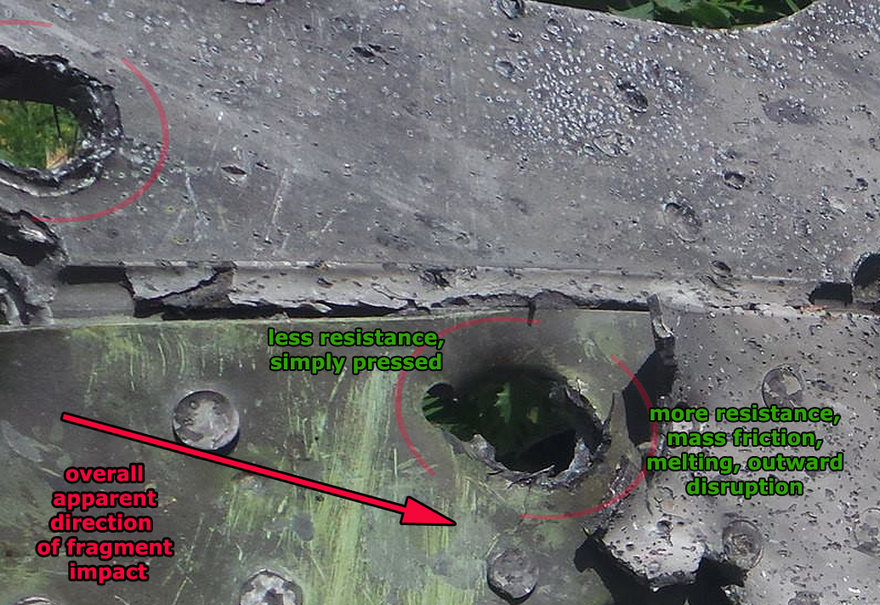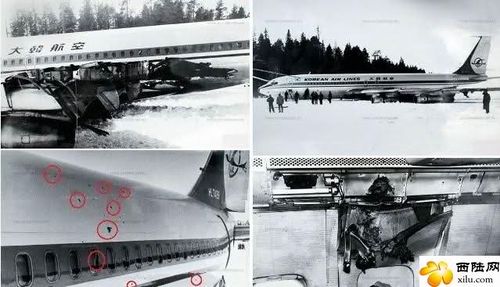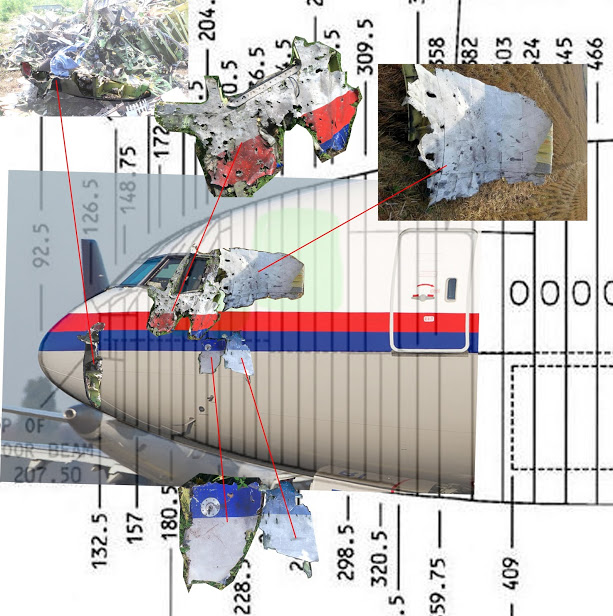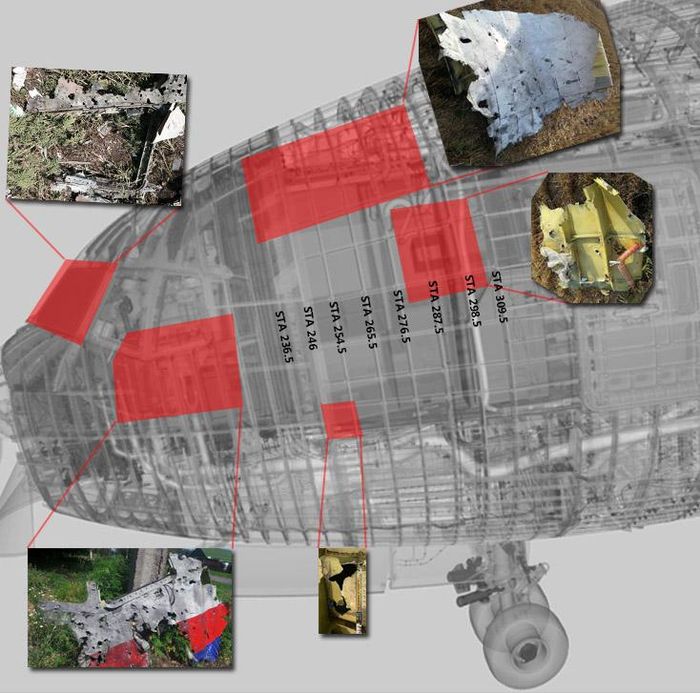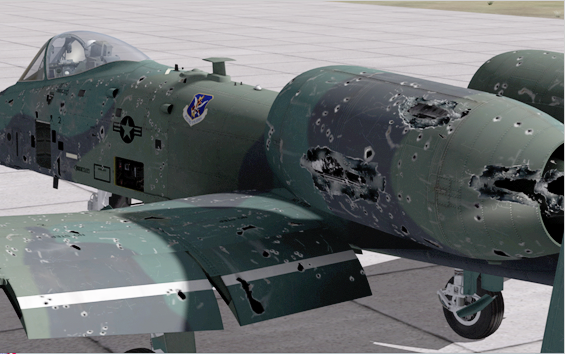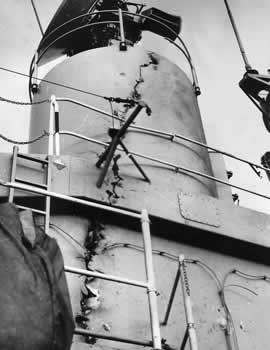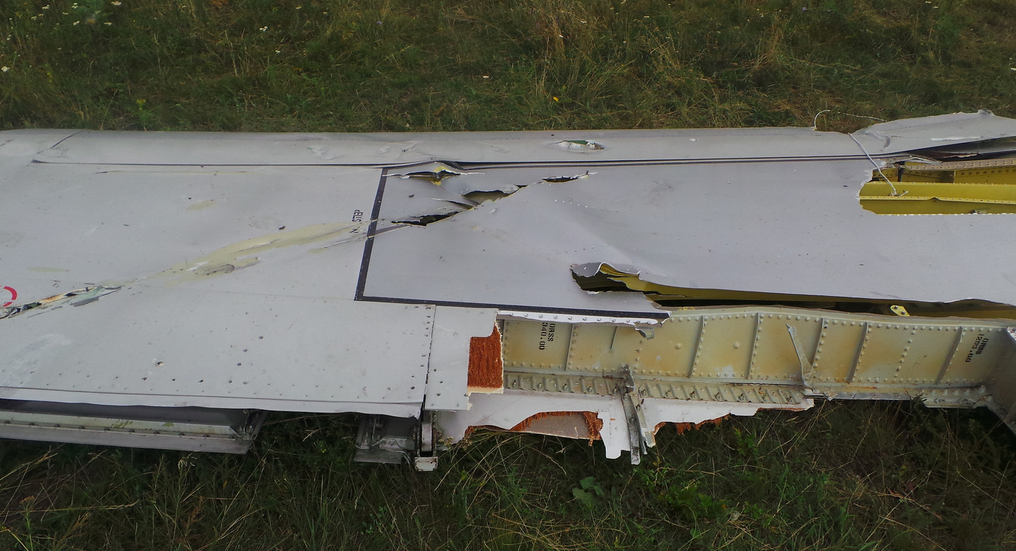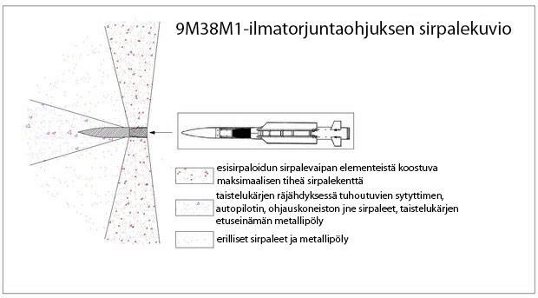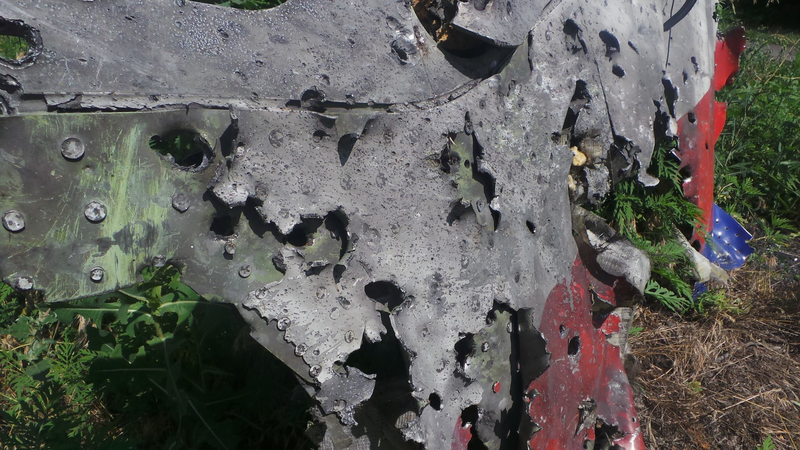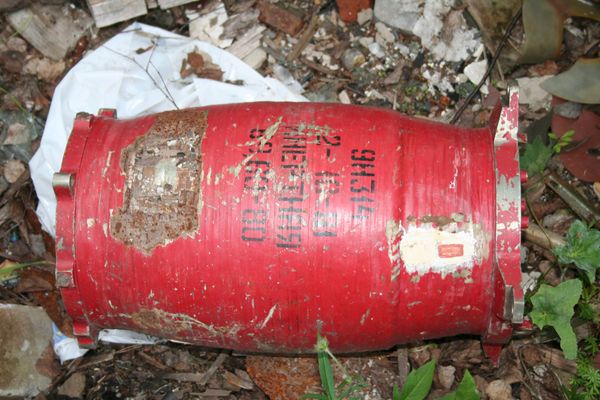Talk:Crash of Malaysia Airlines flight MH17/Forensics
Novaya Gazeta
- Moved to /Almaz-Antay investigation
In May 2015 Novaya Gazeta published online a confidential report prepared by Russian military engineers. Later the same material was published by Almaz-Antay.
Other NG articles
18.05.15 Another publication, different author, of opinion that missile launched from NEE. --Resup (talk) 16:24, 20 May 2015 (UTC)
Novaia Gazeta published its third version, journalist investigation, now back to its opposition roots and blaming Russia (they want to have funding from all sources in the world or what?) No real new evidence is presented, replay of old things with some twists (old missiles left over by Ukraine, and Russian-origin launcher)...evidence is of sort that two unnamed persons made such a claim... but than one commentator is saying that no missiles were left over (in Luhansk, I guess)--so than this new twist appears dead on arrival or close to this... Saving the link; picked up by dw in an instant... --Resup (talk) 08:39, 15 July 2015 (UTC)
Projectile Analysis
Direction of projectiles?
In any Buk theory the shrapnel would have to come from one single direction or source. One attacking fighter would also produce "machine gun" fire from a single direction. Some people see both entry and exit holes in the same segment and thus claim that two different fighters attacked the plane. I believe that all the major holes can be explained by projectiles coming from one direction.
The direction of projectiles seems to be from the front, slightly to the left and slightly above, directed mainly at the captain's chair through the windshield. The projectiles left perfectly round holes of about 20 mm diameter in the upper frame of the port side windshield. Further down the left side the holes became elongated and irregular, some with the appearance of exit holes. The smaller irregular holes on the side are most likely the result of fragmentation rounds mixed in with armor piercing bullets. Some of these may have bounced off the side and exploded outside.
The same direction of the projectiles is also evident in this analysis of the hole in the cockpit roof / side pannel done by the Bellingcat team.

- You reference the "Bellingcat team". Unless you can reference their source material with usable links and evidence of good provenance then such a reference is not useful in any way. Bellingcat is by self-description an agency of Eliot Higgins and uses a paywall to access material so no links are possible. Beyond that the reliability and objectivity of Eliot Higgins is very low. Can you provide original sources please. --Charles Wood (talk) 13:23, 10 August 2014 (UTC)
- Oh, lighten up. Ideally, yes, all primary source, etc. But time gets short, the photos aren't fake, the analysis looks worth considering and bringing here. That side flap shallow penetration is useful to see. Unreliable? On political implications, yes. On physical photo-based stuff, not that I've noticed. --Caustic Logic (talk) 23:45, 10 August 2014 (UTC)
The damage to the left wingtip was most likely produced by debris from the cockpit section hitting the wing (as Charles already suggested). -- Petri Krohn (talk) 04:04, 6 August 2014 (UTC) Updated 08:43, 7 August 2014 (UTC)
Update on wing damage: After looking at the KLA902 wing damage I am more inclined to believe it was caused by a R-60 or similar air-to-air missile. It is not breaking Occam's razor to assume that a jet would use both the autocannon and missiles to bring down MH17 – in fact it would need to do so, if it was to guarantee the success of its mission. Also it is possible that the apparent blast damage and random shrapnel holes on the front port side is caused by a missile exploding and not the autocannon. For arguments sake we can dismiss this. Supporters of a Buk hypothesis can always argue other causes for the wing damage. -- Petri Krohn (talk) 08:20, 7 August 2014 (UTC)
- The wing, okay - it happened while airborne, but it could well be that. I previously thought the left-side damage looked to have a from-behind trajectory. Looking again, it looked more straight in. Looking closer yet, as I show below, I think these holes come from forward, a bit above, and at a pretty oblique angle - obviously a bit to the left, but not much. In line with what you just said, Petri. (from left side, forward cockpit, just below the windscreen - detail from the high-res photo available here) --Caustic Logic (talk) 10:28, 6 August 2014 (UTC)
- I was also just thinking how that ubiquitous graphic lining up the wing damage and the cockpit throws everyone off. We can whip up an antidote, right? Which images should you show me in review and let the reader follow along? --Caustic Logic (talk) 10:28, 6 August 2014 (UTC)
- I note lots of small pockmarks on the photo above, which scratch but did not penetrate. At this location and angle, appear to indicate incoming blast. This cannot possibly come from a blast from the other side, and appear quite unlikely to come from later debris.
--Chingachgook (talk) 17:52, 10 August 2014 (UTC)
- I'm not sure how to read these (and all the micro-physics, cratering stuff, over my head/no useable knowledge or instinct) ... the upper left hole especially shows melting, so there might be little globs of molten metal, if that matters. The bigger craters might just be liquefied marks from smaller (rod?) impacts, but the tiny ones I really have no good thoughts on. Could that be the molten sparks blowing back? Somehow, yes, this is from outside the plane, coming in at an oblique, downward angle, and/or from after affects of that. --Caustic Logic (talk) 08:58, 11 August 2014 (UTC)
- Those pockmarks are consistent with incoming blast. I do not see how they can be consistent with splashed deposited melt: exit jet will have velocities in at least hundreds m/s out of surface (no smaller scale is around), and in fact may be considerably more. For somebody sitting on a plane, there is incoming wind of 0.8 Mach, however out-oh-hole-debris jet speed is at least not negligible on that scale (actually, most likely larger). So melted jet will fly away and not likely to turn around and come back on the surface head-on. While pockmarks are spread pretty evenly and randomly, with no noticeably correlation to holes or downwind directions . (Also there is not that much melting , it appears, to go by). All that suggests that there was some sort of blast on the left side not too far from the cabin (and in the "Single Buk Theory" this does make large holes entrance holes; in other theories, who knows).
--Chingachgook (talk) 18:43, 11 August 2014 (UTC)
Holes on pilot seats suggest it was coming inside from front-and-left, roughly as shown by sticks on photos, and perhaps like in Almaz-Antey theory. That seems difficult to reconcile with wing damage (direction nearly perpendicular to what pilot seats appear to show). Unsure what it means--multiple events?-That would be the most obvious explanation. --Resup (talk) 01:41, 25 July 2015 (UTC)
Sizes of Holes
Lots of slow motions of impacts...including some double-layer, e.g. 0:30 --Resup (talk) 00:49, 19 March 2015 (UTC)
This detail needs careful study and clear illustration. Different kinds and thus sizes of projectile have been proposed. Petri has been describing the larger holes as about 20mm or even 15-20. I haven't seen the work, and I'd like to know how we can even get an accurate measure? If I knew where to get precise sizes for different airframe parts, maybe I could set a scale and compare the holes. Especially, considering the great views we have for that area, how wide is the base of the rear left cockpit window seen in full in picture MH17 left cockpit panel.jpg.? Does anyone anywhere specify how wide the molding around it is? If I had 2-5 known measures to compare, it could be more precise. --Caustic Logic (talk) 04:43, 17 August 2014 (UTC)
It may be close to 30 mm. Holes and heads are ellipse-shaped. If we take a mean of maximum and minimum diameter, on the most visible hole on the sign-posted figure above, than hole to rivet shank diameters ratio is about 2.94, and hole to rivet head is about 1.97. It may be a 3/8 rivet, the largest standard rivet which is not over-sized. Head diameter for such is at least 0.488 inch. Using rivet shank size, that gives 28 mm hole; using 0.488 for the head gives 24 mm hole; with head to 0.5 inch (as 0.488 is the smallest allowed) gives 25 mm hole. Since hole is not perfectly round, and it is made of elastic material, 3/8 rivet gives hole size acceptably close to 30 mm. (We do not have info to be sure it is 3/8 rivet there; but it may be).
- Actually it is better to take maximum (which is not squeezed by a projection) for the diameter of rivet or rivet head, and work out ellipse axes for the hole; that gives about (24.4, 30.7) mm based on 3/8 shank diameter, and (21.7, 27.3) based on the head diameter of 0.5 inch; again quite OK for 30 mm projectile. --Resup (talk) 19:36, 9 November 2014 (UTC)
- You're probably onto something here. I'm not fired up to try measuring again, or even thinking about it in detail, until we have reliable references (like actual rivet sizes, probably the best bet). --Caustic Logic (talk) 00:53, 10 November 2014 (UTC)
- Actually it is better to take maximum (which is not squeezed by a projection) for the diameter of rivet or rivet head, and work out ellipse axes for the hole; that gives about (24.4, 30.7) mm based on 3/8 shank diameter, and (21.7, 27.3) based on the head diameter of 0.5 inch; again quite OK for 30 mm projectile. --Resup (talk) 19:36, 9 November 2014 (UTC)
Another issue is the presence of different sized holes. This must mean a mix of projectiles, with two main explanations offered:
- Auto-cannon (all so far say 30 mm, might be other calibers to consider) plus other (likely air-to-air missile shrapnel, whatever size that is/can be)
- SA-11 shrapnel, which comes in three different sizes packed in layers. As I measured it with some confidence, the biggest ones are app. 13 mm across, 3-D diagonal probably about 20 mm or a bit bigger (see somewhere on the page). Smaller ones, not as sure.
So, if we can show any holes are big enough for 30 mm, those are probably too big for SA-11's largest (but perhaps not - object size is an at-least measure for hole size). And if the holes top out consistently under 30 mm, even just under (and we can for sure say it is) that's probably the actual upper end for SA-11 shrapnel (or maybe it was all air-to-air). And, if we can start to solidify a case for a fighter jet-based attack, I'll still want to see that explained re: the lack of a logical radar track for the jet (it wouldn't appear at the moment of the jet's breakup), the altitude issues, the clues supporting SA-11 launch, etc.) --Caustic Logic (talk) 00:53, 10 November 2014 (UTC)
- Autocannons are typically loaded with a mixture of two different types of ammunition; HA and armored piercing. This even applies to flak-cannons. HE ammo would produce small shrapnel holes. -- Petri Krohn (talk) 11:37, 10 November 2014 (UTC)
Engine Cowling
Engine cowling damage was shown in KP publication, 12 Nov. 2014 and is further discussed here.--Resup (talk) 05:01, 15 November 2014 (UTC)
- That is the leading edge of the cowling. It was found at Petropavlivka, the first village that debris fell on. That was also where a piece of broken main fan as found [1] . A small section of cowling, from the back join, was also found in the area in the first days. Combined with left wing damage and the fact the plane turned to the left, these are all from the port engine (which would have stopped after ingesting fan blades). I'm off to search for the cowling image, maybe I put it here once but can't find it. KatKan (talk) 04:56, 16 November 2014 (UTC).
Projectile Photos
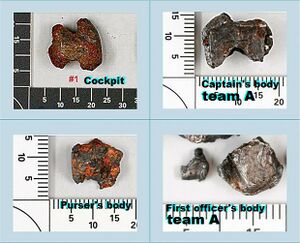

- Censor.net.ua SUBMUNITIONS OF RUSSIAN MISSILE BUK-M1-2 (AKA SA-17) WHICH DOWNED THE MALAYSIAN BOEING MH-17. EXCLUSIVE PHOTO REPORT Showa a blow-up image of hourglass-shaped SA-11 frag next to what seems a battle-tested version, allegedly right from the wreckage. Having studied the Lockerbie bombing, I'm not taking airplane crash science as gospel like some would. Small crap especially can be outright inserted into the evidence chain, even halfway through the probe. But still, I suspect this is the real shrapnel, since there was already so much evidence for a Buk launcher in the area and so little for anything else. --Caustic Logic (talk) 12:42, 18 March 2015 (UTC)
- Newspaper is unlikely to have access to investigators files prior to official report--or else investigators have questions to answer. What is shown on the photo can be made for a fake publication purpose. It is not shown in relation to MH17 at all, apart from a verbal claim with anonymous source. It needs to be deformed and melted by a lot to look like this, which is unlikely from hitting soft skin or bodies. Likely it is propaganda to counter 'rod' photo recently claimed based on early wreckage photos. Clearly purpose of this publication is to affect public opinion, not to conduct an investigation. (Also Buk-M's are all Ukrainian...as we know from the time of Nalivaichenko pre-announcement, he planned to find this quite a while ago... ) --Resup (talk) 14:59, 18 March 2015 (UTC)
- The Censor.net photo is most likely a scan from a printed photo in some old book. -- Petri Krohn (talk) 11:40, 20 March 2015 (UTC)
- Newspaper is unlikely to have access to investigators files prior to official report--or else investigators have questions to answer. What is shown on the photo can be made for a fake publication purpose. It is not shown in relation to MH17 at all, apart from a verbal claim with anonymous source. It needs to be deformed and melted by a lot to look like this, which is unlikely from hitting soft skin or bodies. Likely it is propaganda to counter 'rod' photo recently claimed based on early wreckage photos. Clearly purpose of this publication is to affect public opinion, not to conduct an investigation. (Also Buk-M's are all Ukrainian...as we know from the time of Nalivaichenko pre-announcement, he planned to find this quite a while ago... ) --Resup (talk) 14:59, 18 March 2015 (UTC)
RTL Nieuws / Jeroen Akkermans, (and video here). He is claiming to have pieces which on spectral analyses of X shaped piece give high ferrum, and on missilish piece gives titanium and chrome. Hot cratering on plane parts. How he got those pieces is not immediately clear to me; looks like getting lots of helpful assistance. Russian MoD: "X shape shrapnel is used only on Buk M1 which are used by Ukraine. While Buk M1-2 shrapnel shape is parallelepipeds, no X shapes could possibly be there. Censor.net with its exclusive report just let down its own curators" Igor Konashenkov (Игорь Конашенков), MOD representative --Resup (talk) 22:17, 19 March 2015 (UTC)
- parallelepipeds image search (I didn't know). Interestingly specific and I hope it's right, but being Russian MoD, I'll have to call skeptical for now (actual mixed record). --Caustic Logic (talk) 23:07, 19 March 2015 (UTC)
This historic account describes how idea of 9Н314 came about, out of clashing requirements of high penetration and high coverage (so not heavy). All that was taking place before any Buk went into production, prior to 1980. So X shape is as old as Buk itself, and definitely not something which only can come from Russia (Soviet Union was over in 1991).
- Note: in 9Н314 , Н is a Russian letter N, not Latin alphabet H. --Resup (talk) 02:16, 20 March 2015 (UTC)
Cabin Frame
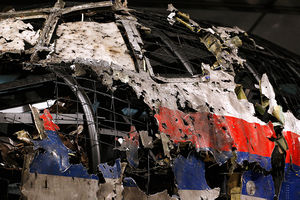
Crucial Buk missile body fragment was embedded in cabin frame, as presented by JIT (from what they tell us, body part, not preformed fragment). Michael Kobs thinks that JIT has it upside down (see his illustration here). Note that after turning it upside down, the longer arm of the horizontal bar of the cross in JIT graphics will not match the shorter left horizontal arm in the assembled on the ground version, see photo. Kobs matching, turned upside down, implies that the hit comes from behind windshield tangentially towards the front, --all that happening on the left side of the plane. After reviewing JIT video, Kobs and JIT talk about THE SAME piece of the frame. However that piece was broken above the link to horizontal frame element, --and that link remained covered by plane skin, see top of List of MH17 airframe parts. So JIT video does not accurately represent the physical state of that piece , and appears to be a computer visualization, not the actual image. Looking at hangar photo, elevated portion seen on the right side of the (vertical) frame link in question, while on the left side there is none (left side is covered by skin and may not even have it, while right side is adjacent to the window and has that extra fixture, perhaps unlike the left side. Anyway, the elevation on the left side is NOT there in the hangar. Now on JIT visualization, it is other way around, elevated portion IS on the LEFT --and it contains the crucial fragment piece, and on the right, nothing. Hmm, turning that upside down is not totally crazy after all. In view of overall significance, at least that issue require a clear-cut answer, and it looks quite awkward for the investigators at the moment. They say it contained a fragment, and is it shown correctly or upside down is significant, possibly crucial, overall--Resup (talk) 10:41, 29 November 2016 (UTC)
DSB final report describes this piece on p 94/279 (orientation/direction of the hit unclear). Possibly this is a multi-layer structure and a layer was taken off; anyway, not a great job making obvious and convincing where it was found --Resup (talk) 15:56, 29 November 2016 (UTC)
Wingtip piece
Fragment inside left wingtip described on p 94/279 of DSB final report. It is part of missile body (large). Location indicated but not immediately clear; direction of the hit not discussed. --Resup (talk) 15:56, 29 November 2016 (UTC)
Missile Photos
- I'm not really into the fake theory on this. I expect it's WYSIWYG. What's more interesting is the version of BUK the fragments are alleged to come from. I have a sneaking suspicion they don't match the particular missile model in the SBU photographs. I've seen (and am unable to relocate) several different warheads for the BUK. They have the exact same top and bottom connection to the rest of the missile but they have different volumes, lengths, radius, and fragment tesselation. So to start, is there any absolute ID on the SBU BUK missile model? That is rather than the usual amateur rubbish from you-know-who? --Charles Wood (talk) 20:32, 18 March 2015 (UTC)
- (1).There was Nalivaichenko photo (undamaged X shape, Cyberberkut), and this newspaper photo (looks like X shape folded up into V and melted a lot) (2). There are different shapes of elements but I don't think information which missile has which shape of shrapnel is available in open sources. There are 3 main missile types, 9M38, 9M38M1, 9M317 (from oldest to newest), and several warheads possible per missile (exact differences not known; indeed different shrapnel element shapes discussed --but not exact details per model). But this Russian source tells that most common warhead used on 3М38 and 3М38М1 missiles is 9Н314, fragmentation type with X shape elements. We have a photo of 9Н314 on this page (marking seen on the photo).
- Added: Russian MoD appears to claim that missile/warheads they use got parallelepipeds, not X shape shrapnel. --Resup (talk) 22:37, 19 March 2015 (UTC)
- While Bul M1-2 is the launcher type (so this is about different radar, electronics, etc). This launcher can officially use the last two missile types and in fact likely to be able to use any of them. In short one cannot tell it is Buk M1 2 and not some other Buk looking at a shrapnel element; at most it tells about warhead only.--Resup (talk) 23:36, 18 March 2015 (UTC)
- I was referring to the missile model on the BUK launcher. Apparently there are fin detail differences between the different models. That should narrow down the possible warhead if it's possible to ID the missile in the several SBU photos. --Charles Wood (talk) 00:57, 19 March 2015 (UTC)
- (1).There was Nalivaichenko photo (undamaged X shape, Cyberberkut), and this newspaper photo (looks like X shape folded up into V and melted a lot) (2). There are different shapes of elements but I don't think information which missile has which shape of shrapnel is available in open sources. There are 3 main missile types, 9M38, 9M38M1, 9M317 (from oldest to newest), and several warheads possible per missile (exact differences not known; indeed different shrapnel element shapes discussed --but not exact details per model). But this Russian source tells that most common warhead used on 3М38 and 3М38М1 missiles is 9Н314, fragmentation type with X shape elements. We have a photo of 9Н314 on this page (marking seen on the photo).
- I'm not really into the fake theory on this. I expect it's WYSIWYG. What's more interesting is the version of BUK the fragments are alleged to come from. I have a sneaking suspicion they don't match the particular missile model in the SBU photographs. I've seen (and am unable to relocate) several different warheads for the BUK. They have the exact same top and bottom connection to the rest of the missile but they have different volumes, lengths, radius, and fragment tesselation. So to start, is there any absolute ID on the SBU BUK missile model? That is rather than the usual amateur rubbish from you-know-who? --Charles Wood (talk) 20:32, 18 March 2015 (UTC)
That's right, 9M38M1 , plus a couple of 9M317 here. Not sure what is that we see on various videos (if anything definite at all). When we see Ukrainian Buks, those are older type, 9M38 or 9M38M1 (big radar on TELAR, large middle-fins on missiles here (some red tips, many launchers) and here (white tip, launcher number 121; date disputed but before 9 May 14, ownership somewhat disputed but almost surely Ukrainian) . The one placed located to Lugansk is same sort as far as I can see (large fins). The one said to be driving in Snezhnoe-unknown. Paris match--not seen. The bunch videoed in Russia, like here, we do not see missiles loaded (in anything I have seen); we only see them on loading Buk (TEL, with a crane fitted on it), and in that case we see only the tip but not the fins. --Resup (talk) 01:13, 19 March 2015 (UTC)
- Looking at the video of the 'post launch' transport It appears the missiles on the vehicle were a short finned type so not a 9M38M1, more likely a 9M317 variant? --Charles Wood (talk) 02:27, 19 March 2015 (UTC)
- You mean Lugansk? What I see looks like large 9M38/ 9M38M1 fins as far as I can tell--Resup (talk) 02:30, 19 March 2015 (UTC)
- At (1:13) we got a glimpse on fins maybe (not entirely sure) and red missile tip; in Luhansk its white tip, FWIW. --Resup (talk) 02:51, 19 March 2015 (UTC)
- I haven't been inspired yet, but if it remains worthwhile soon I can have a look. Just at the visuals, make a graphic. The details about warhead types, that sounds hard to pin down. --Caustic Logic (talk) 11:04, 19 March 2015 (UTC)
- Looking at the video of the 'post launch' transport It appears the missiles on the vehicle were a short finned type so not a 9M38M1, more likely a 9M317 variant? --Charles Wood (talk) 02:27, 19 March 2015 (UTC)
Effects of R-60 air-to-air missile on Boeing airliner?
Korean Air flight 902 is extremely relevant to the MH17 case:
- The Korean Boeing – English Russia, June 3, 2008 (photos)
- R-60 Missile Damage – DeepResource, 06 AUG 2014
- Korean Air Lines Flight 902 – Wikipedia
- Photos: 1, 2
The plane was forced to land by damage from one R-60 missile There are striking similarities between the damage and those seen on MH17:
- Four meters of left wingtip cut off
- A pattern of shrapnel damage on the side of the fuselage where the warhead exploded
Large sections of the fuselage torn open
-- Petri Krohn (talk) 17:57, 6 August 2014 (UTC)
Hypothesis: If a missile approach plane from behind nearly horizontally, its wing has stealthy profile and may be not detected by its (or plane's) radar, thus not triggering proximity fuse well prior to clipping the wing. It really should go off at least 17 meters BEFORE what it considers target. (Does the warhead have a radar on it, or target is illuminated from elsewhere? In any case it is getting closer than it should be). --Chingachgook (talk) 18:14, 10 August 2014 (UTC)
- The R-60 is infrared guided and will aim for the engines. Unlike MANPADs it has a proximity fuse (either radar of optical) and will blow up somewhere near the fuselage. It does not need a radar for guidance.
- If a R-60 was used, it was most likely fired from the same direction as the cannon fire, i.e. front left. It should thus explode in front of the (left) wing and leave shrapnel marks on the front fuselage. In fact, I think there are shrapnel holes and blast damage consistent with R-60 in the side panels behind the cockpit. -- Petri Krohn (talk) 20:26, 10 August 2014 (UTC)
Putting it together
Air-to-air missile or 30 mm autocannon?
The damage will tell us it was an air-to-air missile with rod warhead fired from the front, that exploded when its proximity fuse passed the cockpit window. -- Petri Krohn (talk) 23:04, 28 July 2014 (UTC)
- More specifically,I don't think the angle of impact can tell us anything. Maybe I was the only one that for a minute thought it could - if it scraped the top of the wing, it must've been fired from above the wing, behind and to the left. But it could have just leveled out there after flying up, turning, etc. Other clues are what they are - payload type and size, dynamics I don't know. I note Charles here said the damage looks less like a rod than regular shrapnel, if that matters. For my part, I'm suspecting Surface fired, partly because the people who should know (Kiev) keep saying that and claiming they can show you the exact launcher. Maybe they can and did. Maybe the jet was there to help explain why the separatists did it, and to observe, or something. --Caustic Logic (talk) 23:14, 29 July 2014 (UTC)
- This analysis say it was a 30 mm autocannon. Maybe. (English summary + another) One thing is sure; it was not a Buk or fired from the surface. -- Petri Krohn (talk) 23:22, 29 July 2014 (UTC)
- Russian analysis says it is not a Buk. -- Petri Krohn (talk) 23:36, 29 July 2014 (UTC)
- Since that's what I suspect at the moment, some discussion should follow. Will check those links soon. --Caustic Logic (talk) 23:42, 29 July 2014 (UTC)
- Effect of 25mm and 30mm cannon shells Gives an extremely good idea of what cannon shell damage looks like. I don't see any damage pattern on MH17 wreckage to match that. On the other hand the damage pattern from a proximity detonated shrapnel warhead is entirely consistent with the damage. E.g.
- An expanding rod warhead is eliminated as there is no damage match. E.g.
- Damage to the left wingtip is variously being touted as an R60 air-to-air missile expanding rod strike or a 30mm cannon strike. It's not an expanding rod strike as it scrapes rather than penetrates the skin in a line. It also does not match a 30mm cannon strike as there is no detonation pattern and 30mm rounds don't 'bounce' as they skip along a wing surface. It's suggested that this damage is actually from later debris falling on the wing.
- --Charles Wood (talk) 03:39, 30 July 2014 (UTC)
- As addition to the video posted above - this video shows the 30MM cannons of a SU-25 are testfired in a short burst on some grounded obsolete jet fighters. The damage pattern on the exit hole side later in the video and the direct comparison to the famous MH17 cockpit fuselage shows a lot of visual similarities, explaining the symmetric round holes, small punctures and also the the asymmetric torn fuselage due to the projectiles partially exploding inside the target. --Boobybay (talk) 03:28, 09 November 2014 (GMT+2)
- Thanks! We have discussed this video on the main MH17 talk page . The thing with SU 25 is that it cannot not have a stable flight at 10,000 m, at most it can 'jet-in' there for a short time. Also it is slow, about the same speed as Boeing; and has no oxygen mask for pilot. This makes SU-25 rather impossible as a primary cause. It could be used to finish off. Many MH17 holes appear to be small, fingertip size, and in places squarish; this is mostly consistent with a missile shrapnel, either surface-to-air or air-to-air, there is not much difference shrapnel-wise. --Resup (talk) 04:09, 9 November 2014 (UTC)
- The shrapnel holes on the exit side are somewhat similar to the holes in the cockpit floor. I think the entry holes are far larger on this video. The targets are however not at all similar. The side skin of the fighters is thin and soft. The front section of the 777 cockpit is hardened to withstand high speed collisions with birds. Parts are made of titanium. Unfortunately the video does not specify the type of ammunition used. HE or armor piercing or a mixture?
- Resup. This is not really the place to discuss whether the Su-25 can fly at 33,000 feet. The issue is strictly the analysis of the holes. Are these from 30 mm or from 23 mm bullets or something else. I guess a Su-25 would normally carry a mixture of HE and armor piercing bullets, maybe saboted. -- Petri Krohn (talk) 07:38, 9 November 2014 (UTC)
- I agree with Resup's doubts of course, and still wonder why people latched onto SU-25 in the first place ... so let's be fairer and ask was it (any size) autocannon mounted on something that, presumably, could do the trick? I still doubt it, but I say we need to get solid hole size measurements before we can get far... Nothing else to add yet. --Caustic Logic (talk) 10:13, 9 November 2014 (UTC)
- To know hole size, need to know size of something, rivets (or accurate window frame sizes perhaps). This looks like 2.5-3 rivet-tops diameter hole; but I do not see rivet sizes Boeing 777 published. 15-30 mm size seems not unreasonable, but not knowing exactly does not tell much. Somebody might be able to figure rivet diameters (rivet tops or holes). In strong and elastic material, (entry) hole may be somewhat smaller than 'bullet' size, actually. SU 25 is supposed to have 30 mm 2-barrel automatic gun; MIG 29, 30 mm one barrel gun (so twice more bullets per second from SU 25, otherwise not much difference). --Resup (talk) 15:05, 9 November 2014 (UTC)
- I agree with Resup's doubts of course, and still wonder why people latched onto SU-25 in the first place ... so let's be fairer and ask was it (any size) autocannon mounted on something that, presumably, could do the trick? I still doubt it, but I say we need to get solid hole size measurements before we can get far... Nothing else to add yet. --Caustic Logic (talk) 10:13, 9 November 2014 (UTC)
- Thanks! We have discussed this video on the main MH17 talk page . The thing with SU 25 is that it cannot not have a stable flight at 10,000 m, at most it can 'jet-in' there for a short time. Also it is slow, about the same speed as Boeing; and has no oxygen mask for pilot. This makes SU-25 rather impossible as a primary cause. It could be used to finish off. Many MH17 holes appear to be small, fingertip size, and in places squarish; this is mostly consistent with a missile shrapnel, either surface-to-air or air-to-air, there is not much difference shrapnel-wise. --Resup (talk) 04:09, 9 November 2014 (UTC)
- As addition to the video posted above - this video shows the 30MM cannons of a SU-25 are testfired in a short burst on some grounded obsolete jet fighters. The damage pattern on the exit hole side later in the video and the direct comparison to the famous MH17 cockpit fuselage shows a lot of visual similarities, explaining the symmetric round holes, small punctures and also the the asymmetric torn fuselage due to the projectiles partially exploding inside the target. --Boobybay (talk) 03:28, 09 November 2014 (GMT+2)
- Here is a video of 7.62 mm AK bullets fired trough a piece of aluminium or titanium. -- Petri Krohn (talk) 02:04, 3 December 2014 (UTC)
An entry in 'hole size' subsection above shows that hole size may be consistent with 30 mm. I also recall watching recently how machine gun ammunition is loaded on ammunition belt, there is some mechanical device doing it pretty quickly. I noted that a mixture of ammunition types (differently colored tips were present). So it may be a mixture of explosive fragmentation ('осколочно фугасные') and of armor-piercing sort (just solid steel tip, say). Seeing apparently different sort of holes close by in the cockpit area gives some support to such scenario (it appears to have much larger holes as well, and some small dents on surface). If it is a missile and is not insanely close, it is expected to produce uniform in size shrapnel shower, of about 15 mm diameter (Unless somebody fiddles with warhead, Ukraine 'modified' something, but different-sized shrapnel is still unlikely). What we see outside of this small pilot cabin area, looks a lot like normal missile shrapnel. In the pilot area, it's uncertain/'debatable'. --Resup (talk) 20:29, 9 November 2014 (UTC)
- Exactly the opposite is true; the BUK warhead has a mixture of shrapnel of different sizes. This should be reflected in different size of holes. On an autocannon, if two types of ammo are used, they might hit slightly different spots. Different ballistics. Also, on a two-barrel cannon a 1-to-1 mixture would guide different types to different pipes. The pipes might be poorly adjusted. -- Petri Krohn (talk) 02:04, 3 December 2014 (UTC)
- There are different reports on BUK shrapnel (reference?), and it may differ for different warheads. Picture below suggests that shrapnel is formed by outer metal pipe, on the picture, all pre-cuts are same-shaped. Reports I remember from Russian sources were saying essentially the same. I also seen reports that different shape shrapnel (balls, for example) may be added on top of that, but that was about modern versions and so most likely does not apply --Resup (talk) 02:16, 3 December 2014 (UTC)
- If you mean air to air missile, not Buk, not sure is it same or different shrapnel size. Different bullets likely have the same ballistics, same aerodynamics (and same everything else).--Resup (talk) 06:32, 3 December 2014 (UTC)
Left Wing Damage
(copied from above to start this section) Damage to the left wingtip is variously being touted as an R60 air-to-air missile expanding rod strike or a 30mm cannon strike. It's not an expanding rod strike as it scrapes rather than penetrates the skin in a line. It also does not match a 30mm cannon strike as there is no detonation pattern and 30mm rounds don't 'bounce' as they skip along a wing surface. It's suggested that this damage is actually from later debris falling on the wing.
--Charles Wood (talk) 03:39, 30 July 2014 (UTC)
- Wing damage after/during crash: I thought that too on first look, but based on nothing. Since then I decided the irregularity of the windward edge of that tear suggests it was rippling with airflow as it was torn, so it was airborne at the moment, anyway. That's a lot of scattered, forceful, linear action lining up with the cockpit to be coincidental (brush damage?) - I think this is munitions damage. Another gouge I found interesting is a more likely mechanical cut from the plane falling apart after the attack. Seen closer up and seen in context (just southeast of picture's center) --Caustic Logic (talk) 09:58, 30 July 2014 (UTC)
- Wing damage appears consistent with projectiles moving towards the plane, not away from the plane.
- Depressions are towards the wing back edge, glancing scrapes are towards the front. If motion is away from plane, there is no escape root from the depressed part. Thus I feel hit is coming from the back-left , moving towards the pilot cabin. This appear to contradict an assumption of front-to-back hit (but not the overall conclusion) made by a Buk expert.
- Agreed that some of the damage towards the wing front appear to be due to incoming air drag. Such drag, subsequent chaotic fall, may explain why wreckage is not aligned with the plane course.
- Very unlikely that damage is not due to a projectile of some sort at all: a lot of relative speed and glancing blow. --Chingachgook (talk) 22:21, 9 August 2014 (UTC)
- Hey, I think I get what you're saying, agreeing with what I said. But since then, it's come to appear the blast/attack (if only one) was from the front and this wing damage is coincidental. I still thenk it was while airborne, but there was some breakup then. Direction, I'm not sure. It should be away from the plane, if it's plane fragments that scraped across here. It seems like the forward part is what came apart early on, and any piece of it could cut the wing open as it nose-dived past the chunk with less mass and more drag. So, I can/have seen it both ways. --Caustic Logic (talk) 23:42, 9 August 2014 (UTC)
- It was, kind of, similar to stone skipping. I expect smoother, more shallow part of the dent to point in the direction of the motion, that is towards the plane as detailed dent photos suggest. Should not be difficult to do experiment, sand or something, to confirm. This also suggests nearly horizontal impact angle. (All of that does not look consistent with front or right- fired Buk) --Chingachgook (talk) 05:14, 10 August 2014 (UTC)
- I come from 2 other sites looking at the forensics (not politics) of this crash. We have not liked the "rod scrape" idea for this damage. Have you considered it may be from other debris? specifically, parts of the engine cowling? this was shot off in the initial attack (whatever that was). One part of it was found at Petropavilvka, and engine fan blade pieces elsewhere, well before the final impact. Such a piece could skid across the wing at a flat angle like this. KatKan (talk) 20:12, 13 August 2014 (UTC)
- The engine is under the wing, so it seems unliklely. As Petri and CHarles suspected, and now me too, a piece from forward of the wing and maybe above, not right under. The forward fuselage, cockpit area, anything from the front falling off and back, with drag as the rest of the plane continued past, would cause this. --Caustic Logic (talk) 22:04, 13 August 2014 (UTC)
- We have not, really. Source of cowling damage is unclear but seems independent from the wing damage. It looks that wing damage has to do with shrapnel of some sort, rather than secondary debris (it is not downwind , and A LOT so, thus it is fast; and also it is pretty solid). If it hits the MH17 engine fan, that will indeed create very violent debris, and go everywhere it can get on a straight path (there will be little little out there to stop it), and predominantly downstream. This is not likely to give glancing blows to the top of the wing though, no such straight paths. There are cases of blown fans recorded, it can be looked up. Some blows to the body, mostly downstream or near engine, as far as I can recall. Most planes survive blown fans, but with damage often to wings, they will be often crashing. So in short, engine and wing top appear pretty independent issues.
- Direction of wing damage may be EXTREMELY important for overall conclusion. I keep saying that it is more consistent with moving towards the cabin than away from the cabin based on traces it made, as it is too rough on back of those dents and very smooth on front. Exactly what it was flying, would really need more than just looking at photographs to be sure. --Chingachgook (talk) 22:57, 13 August 2014 (UTC)
- The engines are tested very hard to make sure damage gets pushed through and ejected out the back, rather than blowing the side of the engine. This is for things like bird strikes, hailstorms etc. If bullets have gone through the side, this is not guaranteed (or tested for). The fan piece found was broken, no shooting holes. I can only find one fan assembly in the wreckage photos, and that has to be of the right engine, as that was still running until the crash. Anyway the fan is too far under the wing to damage the top of it. The cowling though is ahead of and just below, so might be thrown up if broken. It is only fibreglass with light honeycomb padding, so would not be very sharp. YES would be lovely to see the actual pieces, not just photos. KatKan (talk) 00:22, 14 August 2014 (UTC)
- a)the chance of a rod or a whole missile just skimming a wing exactly in the same plane is very close to zero
- Not really, for example, it may be coming to it on a chasing trajectory (we do not know exact self-guiding method, do we? We only think it is most likely to implement a straight line? I am not sure why would anybody bother to hardware chasing approach, but we do not know and such details are not available) It may be also more than one event (although there is no clear evidence to support it and so I am not proposing it). My best take on it that (a) it was trying to get on top, but that did not work as it should and it ended up too low (b) on its final approach, it is supposed to get horizontal(ish). It appears from a drawing somebody found somewhere that most of shrapnel goes radially off its cylindrical shape (whether or not reference is reliable that makes some sense), and so getting horizontalish for something which is supposed to be below looks the best apriori plan. That drawing also appears to suggest that something separately goes pretty much forward (but I am not sure and I do not undersdand what captions say) [2] --Chingachgook (talk) 13:28, 17 August 2014 (UTC)
b) any missile that manages to do that would MISS THE COCKPIT.... the tip of the wing is level with the windshield, so anything skimming the wing can't hit way below the windshield
- Not really, for example stones skipping of water are best if incoming at 20 degrees down, not horizontal at 0 degrees. At a length of 30 meters, 20 degrees down would be a lot, like 10 meters (I am not saying it was coming at 20 degrees). --Chingachgook (talk) 13:28, 17 August 2014 (UTC)
c) heat damage and other directional damage indicates the missile detonation was lower (about level with the engine) and to the front. Look at these drawings to see what I mean. http://www.aer.ita.br/~bmattos/mundo/images1f/boeing_777-200_3view.gif KatKan (talk) 11:33, 17 August 2014 (UTC)
- Well, we do not know, but it looks like too little shrapnel damage for something coming on it head-on. Would not that cause lots of shrapnel wounds we do not seem to see? There is no reason for radar guided thing with 70 kg high-power stuff on it and approaching head-on, to do, what appears, little damage (why no heavy shrapnel damage to engines and just about everything else?) unless most of shrapnel indeed ended up going away. It looks more that it kind of skipped and overrun getting pilot cabin area hit only. There seem to be no problem-free hypothesis, more facts need to be known to decide . If any part of trajectory is recorded by satellite, that should be more helpful than second-guessing all this rather peculiar damage --Chingachgook (talk) 13:28, 17 August 2014 (UTC)
I mean, if they are head-on, they are colliding at (3+0.8)=3.8 Mach and this incoming "bird" is at least like 100 kg, even if it does not go off AT ALL but hits the engine, there will be no engine to be ever found I guess; with added bang, that won't make things much better I suppose. If it is over-running, without going off it would be moving away at (3-0.8)=2.2 Mach, and this is kind of better (i.e less shrapnel damage). Depends on shrapnel velocity of course (don't know, and this will tell something), but still better than the other way around --Chingachgook (talk) 14:54, 17 August 2014 (UTC)
Warhead damage
Financial Times clames their photo shows BUK type shrapnel damage.
- MH17 crash: FT photo shows signs of damage from missile strike – July 21, 2014
I do not quite agree. The 70 kg warhead should produce larger damage. All warheads – even rod warheads – produce some shrapnel. -- Petri Krohn (talk) 08:13, 22 July 2014 (UTC)
- FYI - the aircraft panel in the link image is the left-hand cockpit wall and the start of the lefthand windscreen at the top. That's where the Captain sits. I doubt he survived the initial engagement.
- Also interesting is the latest 'leaked' US intelligence map showing the missile launched from right of track and curling around to attack the left. A bit of a stretch to fit a theory?
- --Charles Wood (talk) 01:07, 23 July 2014 (UTC)
- This image shows cockpit seat rails and rear centre consul. Note at bottom what appears to be RH / first officers windscreen frame with shrapnel egress.
- https://secure.flickr.com/photos/jer...7595/lightbox/
- https://www.flickr.com/photos/jeroen...ream/lightbox/
- same windscreen from different angle amongst plant. *note what appears to be shrapnel damage to pilots seat back just below top inertia reel.
- Combined with ingress damage on PIC side, the shrapnel will have taken out both aircrew instantly
- --Charles Wood (talk) 03:57, 23 July 2014 (UTC)
- Your photo links are broken. Are they from the same photoset? I do not see any cockpit parts in the same set with the tail section photos. There is another set here and even more damage photos here. Still don't know what photos you are referring to. Evidently this cockpit explosion did not disintegrate the whole front section of the fuselage, as the BUK warhead would have done, if it exploded near the cockpit. Photos I have seen show the intrument panel without any shrapnel damage, with glass broken by the impact on the ground.
- If the missiles were fired from the Su-25, then most likely multiple missiles would have been launched. If only one missile was used, as would be the case with the BUK then the "rod" damage to the upper side of the left wing would have to come from the same explosion. If you follow the lines in the drawing here then the explosion would have to be very near the fuselage. This makes me believe a small air-to-air warhead was used.
- Can you identify where the other body panel with blast damage is from?
- P.S. – Strelkov noted that there was blood in the cockpit but the passengers were "lifeless" and bloodless. This would be explained, if the pilots were killed by shrapnel and the passengers by loss of cabin pressure at 33,000 feet. -- Petri Krohn (talk) 11:07, 23 July 2014 (UTC)
- The links worked when I posted them. Odd. They were jeroenakkermans images of the cockpit area. A big heap of wreckage with keyboards etc visible. I can only affirm they showed some cockpit skin and pilot seat amongst many other items and it was clear there was damage in from left and out through right when looking at identifiable parts. Will search the image archive later.
--Charles Wood (talk) 12:17, 23 July 2014 (UTC)
- Note: broken here too. Might be around in a diff. posting, etc. I'm looking a little at the images that are here but not enough to say anything yet - I'm convinced it's well worth doing and things can be figured out - will catch up in time. --Caustic Logic (talk) 12:28, 23 July 2014 (UTC)
- This one shows Right-hand cockpit window at bottom of screen. All photos in this group are cockpit remnants--Charles Wood (talk) 20:25, 23 July 2014 (UTC)
These photographs show clear rod warhead damage to left wing.
- Scenes of MH17 20-7-2014 – Jeroen Akkermans RTL News Berlin
-- Petri Krohn (talk) 08:13, 22 July 2014 (UTC)
- Wreckage Offers Clues on Why Flight 17 Went Down – New York Times, July 21, 2014
- Photographs of a piece of wreckage found by two reporters for The New York Times and analyzed by Reed Foster, a defense analyst with IHS Jane’s, offer some clues about what could have caused Malaysia Airlines Flight 17 to crash. While it is impossible from the photographs to determine that a specific missile was used, Mr. Foster said, the damage is consistent with the effects of a fragmentary warhead carried by an SA-11, the type of missile that American officials have said was most likely behind the attack.
- Weasel words to note: impossible to tell what missile (correct, makes you seem balanced) It's consistent with many types of missile, therefore. But they only say "consistent with ... the type of missile that American officials have said" is part of the tragedy "made in Moscow" as they say. In between, the most loaded and likely relevant specifics right in elipses there, to make that one consistent missile type sound like the most technically likely, boosting the gov. call, in turn boosting the "confirmation," etc. Bad weasels.--Caustic Logic (talk) 12:28, 23 July 2014 (UTC)
- Does MH17 wreckage prove that it was shot out the sky by a warhead? – Daily Mail, 22 July 2014
- The photos show the critical piece with blast damage and "shrapnel" holes. I think it proves exactly the opposite to what the Daily Mail is claiming. The 70 kg BUK warhead would have done much serious damage. This piece seem to be torn off by a rod warhead of a air-to-air missile. -- Petri Krohn (talk) 22:38, 22 July 2014 (UTC)
Very peculiar shrapnel direction (so it can chase the plane and totally bang off pilot cabin, and have a lot of its other potential wasted? ) Do front and side cones go off simultaneously or with a delay? Don't know what captions say, why is frontal cone shown lighter than side cone? --Chingachgook (talk) 03:37, 12 August 2014 (UTC)
"Bukin anti-aircraft missile warhead open source is slightly conflicting information. Presumably, the 70 kg at the forefront of the battle of the cylindrical explosive charge on the long sides is either esisirpaloitu tubular sheath or layer of spherical or cube shard elements. Herätesytyttimen Normal setting is 17 meters away from. Sirpalekuvio is the main missile transverse to the longitudinal direction of the expanding sector of a front view of the expandable cage. Battle of the tip located in the front of the missile parts create its direction of travel according to sirpalesektorin and other structures formed by missile fragments are spread randomly" Reference
This source shows outer shell of Buk warhead; it is pre-cut so this one will give shrapnel of same side. Some stuff flows to the front (detonator, front wall, etc); most goes radially off cylindrical pipe. Although not shown by source, but back wall will also produce some shrapnel elements. --Resup (talk) 02:28, 3 December 2014 (UTC)
Type of Warhead
The main page links offsite to an article about 'rod' damage to the aircraft.
The damage pattern is not 'rod' i.e. expanding rod - which is a linear set of damage in a single plane, often contiguous. Instead it's a typical shrapnel pattern, possibly slightly directional. This sets the type of warhead used and possibly even the missile type - assuming it was a BUK launcher. --Charles Wood (talk) 21:25, 28 July 2014 (UTC)
Not a Buk?
Responding to Petri's non-BUK analysis links: the German analysis - the second guy sounds fishy. Most of the damage looks too irregular to be bullet holes. But then some of them, especially on the left here, do look consistent to me. I'm no weapons expert. It's possible it was hit with two different things at different times. (image below is huge - full size in new window gives some great detail) --Caustic Logic (talk) 09:49, 30 July 2014 (UTC)
Okay, the Russian analysis - Google translated: "The probability that a passenger plane was shot down by a missile fired from "Buka", is negligible, said Maj. Gen. Cruz in an interview with "Military-Industrial Courier."
- "All openings of submunitions on the paneling" Boeing "suggests that undermining warhead was done bottom-side. But our "Bukovskaya" missile hit the top, making the "hill" in front of goal. That is the only way, not the other way "- says Cruz.
- Is that him thinking like I was for a minute, that it must have been first fired from above, because of the wing damage? He also points to a smoke trail that should be visible for a BUK missile when there isn't (worth looking into) and he thinks they'd need more training than they had, while showing no sign of knowing how much training the relevant people had. Not too impressed with "Cruz." --Caustic Logic (talk) 09:49, 30 July 2014 (UTC)
- If a missile is aimed above the target, then obviously it will hit it from above. But if it is aimed below it is not going to go above it by itself, so that statement is useless. At most it shows Russian best practice,not a characteristic of the missile itself. --KatKan (talk) 20:27, 13 August 2014 (UTC)
- Looks lie he is saying that navigation/control always tries to put it on top. But that does not mean it always deliver. Good to know, I guess. --Chingachgook (talk) 23:10, 13 August 2014 (UTC)
- No, straight ballistic projectiles (terminology?) like bullets have their line and that's it. If we're talking missile, they have guidance systems to guide the movements they can make. Up, down, left, right - I'm pretty sure (but no expert) they can do all that. --Caustic Logic (talk) 09:25, 14 August 2014 (UTC)
- This is not about what it can or cannot do, it is about what it tries to do. It has self-guided head, which tries to do something . It is not totally impossible to turn, but this is no Iron Dome, nor a computer game with a joystick --Chingachgook (talk) 17:26, 14 August 2014 (UTC)
- The damage could not be from above, because where are the holes on the top? NOWHERE. Even in the cockpit area, there is nothing above the top of the windows, but there ARE holes in the cockpit floor. Further there back there are 5 small holes on the fuselage roof,which might be from inside out. The front door is missing, so we can't tell about that. There was damage to the port engine, deep in, where the fan is, as parts of blade have been found well ahead of the impact area. The blast seems to be from just a little underneath, at a very flat angle. KatKan (talk) 20:27, 13 August 2014 (UTC)
- First, where did you hear about or see holes in the cockpit floor? That's new to me. As for the top, the fact that there is nothing (we've seen) should suggest caution saying what it doesn't show. It also might show it was damaged, tore off early, and spread farther than journalists have yet. Investigators will be seeing interesting parts we haven't. Consider the Mudman putting together graphic above, then the Bellingcat team graphic below it (#Putting it together). There's the curled panel with disagreement over where it goes - roof vs. upper side, with the second one I think set by structural clues ("station numbers" is it? Each "rib" has a number). Wherever it i goes, note also all tha parts we haven't seen and can't call. And on what we have seen, my best cloes up look at the holes themselves suggests downward angle (see below). What's wrong with these analyses? How did the right windscreen frame get so damaged from below? Etc. --Caustic Logic (talk) 09:25, 14 August 2014 (UTC)
I agree, it looks as if was hit with two different things. It is not possible that this happened at different times. The "two different things" can be explained by a mixture of armor-piercings and fragmentation ammo. (This is I suppose what a Su-25 would normally carry when attacking tank columns.) The real problem here is that I do not really know if these are exit or entry holes. I see some blast damage on the outside. The "cockpit roof / side panel" piece seems to show soot and slight buckling caused by an explosion on the outside. How long would it take for the frags to explode after passing through the aluminium skin?
Adam, could you create a stereoscopic image of the holes? Take two images of the same area, scale and cut them to exactly the same size. Two .jpg images would be good to flip-flop between. Maybe a flashing .gif for social media. -- Petri Krohn (talk) 13:23, 30 July 2014 (UTC)
- Hm, maybe. Never tried that, they'll be at different angles, etc. Explain in e-mail. I'm slow today. --Caustic Logic (talk) 22:16, 30 July 2014 (UTC)
- You need to be aware the panel has two different metals above and below the join line. The upper material is in immediate proximity to the windows and is much thicker and stronger - probably titanium. The lower material is Aluminum alloy - perhaps 80 - 160 thou thick. The splash pattern on the thicker/stronger material at the top is characteristic of high velocity impact in strong materials with subsequent cratering. The lower damage is characteristic of particles punching their way through thin metal with little or zero cratering effect.
- --Charles Wood (talk) 14:20, 30 July 2014 (UTC)
- Would this cratering be visible on the ingress or egress side? Or both? I would expect the the patterns to have radial structure, but they all seem to be tilted the same way. -- Petri Krohn (talk) 15:13, 30 July 2014 (UTC)
Shrapnel Fragment Size
Compare with Figure 3, Novaia Gazeta . So our figure caption should be: Left: dummy-for training (инертная seen on the marking) 9Н314 warhead (top line of the marking) , 9М38 missile. Right: not dummy, 9Н314М warhead, 9М38М1 missile. --Resup (talk) 12:55, 6 May 2015 (UTC)
I'm not sure this is the same warhead we'd be looking for, but likely - if the SA-11 has one type of warhead, this is probably it. Charles posted this photo of an unexploded SA-11 warhead, plus a close-up on another area (further detail yet, below).
Where/when the photos are from, not sure, but they are the main feature in an August 2014 report by Richard M. Lloyd, available here. He thinks this is an SA-11 warhead, apparently the only one, and thus a clue to the MH17 case. He compares this with schematics to show it's the right size (you'd think he could have more definitive sources...) If the overall rocket is 5.5 meters long and .4 meters at the widest, the warhead area must be (about) 8 inches/ 20 cm in diameter at most, and thus maybe 12 inches/30 cm long? From there, I put the section with frags about to scale on the other image (it involves flipping one). At full resolution, it seems the big photo is about 150% life-size (the warhead measures about 12" by 18" on-screen), so the 3.75" exposed portion is about 2.5" real-life, if I scaled it right. If so, there are five rows of fragments, so they should be about a half-inch square (on-screen: app. .75" each) or about 13 mm - to holes in the hull measured as around 20 mm. This might be significantly off - it was a first try. And, considering the 3-D aspect, the final hole would be bigger than 13 mm, depending on the angle.--Caustic Logic (talk) 07:02, 10 August 2014 (UTC)
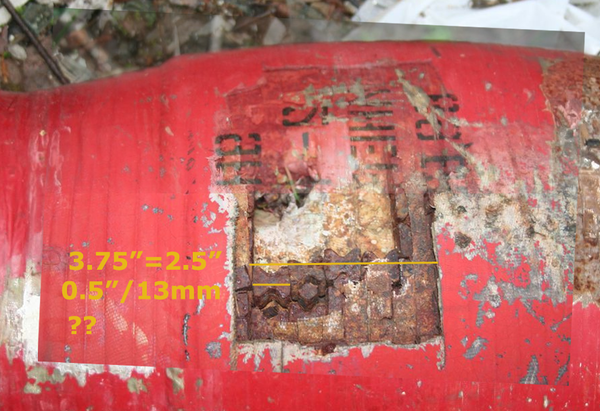
Former NVA Officer Bernd Biedermann (with the rank of Oberst ret. in the East German Military and possibly proficient in knowledge about the alleged weaponry hence the NVA used soviet weapons) describes the shrapnels being utilized by the BUK warhead as small metal cubes the size of a thumbnail. This would add up to the shrapnels being portrayed in the pictures pictures of the SA-11 warhead. The german only interview can be found here: Absturzanalyse ll NVA Raketenexperte Oberst a. D. Bernd Biedermann (Radio Stimme Russlands. --Boobybay (talk) 03:04, 09 November 2014 (GMT+2)
Cratering and hole size
In impacts where there is significant surface depth, relative surface hardness, and high impact velocity you get a neat cratering effect that is similar to moon craters and splashes in water. The shape of the impactor is mostly lost and all that remains is a fairly symmetrical round impact crater.
It's not in the least unreasonable that a ~13mm irregular impactor into thick titanium produces an ~ 20mm circular crater - whether or not it actualy penetrates.
It's only when the surface is very thin and soft that cratering disappears and shape punching occurs. Of course this all depends on impact velocity. There will be a whole spectrum of shapes from simple indented punch marks to nice round craters blasting back in approx the direction the impactor came from (though mostly orthogonal to the surface) --Charles Wood (talk) 07:18, 10 August 2014 (UTC)
- It indeed may have some similarities to cratering. (However, my understanding is that "classical" cratering assumes projectile velocity higher than material speed of sound (also deep material -no exit). Aluminum speed of sound is maybe 3000 m/s or more, above Mach 10 in the air. Most likely, projectile speed is less than that, so for impacted material it is likely "subsonic"--less than assumed in classical cratering). --Chingachgook (talk) 12:55, 10 August 2014 (UTC)
- That's simply not true. You can get 'cratering' in water by lobbing a stone into it at some tiny fraction of the speed of sound in water.
- Cratering in metal is a complex interaction of solid, plastic, and liquid response with localised phase-change depending on impact energy. Essentially the impactor changes the local phase of the metal due energy release, and the bulk physical properties of the material and impactor may then produce a 'splash'. Nothing to do with the prior bulk material speed of sound. --Charles Wood (talk) 13:07, 10 August 2014 (UTC)
- I agree with all that, still in deep material moving faster or slower than sound in material propagates makes a difference to those complicated details.
- Craters on planets we observe are from supersonic events. Over here we most likely have it "subsonic". --Chingachgook (talk) 13:36, 10 August 2014 (UTC)
- State of knowledge here is likely what's known about relationship of entry size and caliber for bullets. I am not aware of good references, here is some It is complicated, may be bigger than caliber, but likely not much bigger. For "supersonic" entry, expect more outside damage (shock wave). --Chingachgook (talk) 14:41, 10 August 2014 (UTC)
- Sounds reasonable to me. Also to note, if this device was used, I see little clumping happening. Little blocks and littler rods, all distinct, for consistent sized holes - 2 main sizes. Is that consistent with what we see? --Caustic Logic (talk) 08:20, 10 August 2014 (UTC)
- My understanding of the warhead shrapnel is that it is in two layers and in each layer it tesselates two basic designs of different sizes - a larger butterfly pattern and a smaller diamond/cubish pattern (memory may be faulty so check) --Charles Wood (talk) 08:25, 10 August 2014 (UTC)
- yes, you can see the smaller ones in that picture, to the left. So there will be at least three types of fragments involved. The block ones seen biggest, and I think they would come out making the bigger holes of about 20 mm. 13 mm square (again, rough) would have a diagonal of about 18 mm, a better measure, and depending on thickness, a 3-D diagonal of about 20-22 (? no real math there, until there's firmer numbers to work with anyway). --Caustic Logic (talk) 12:13, 12 August 2014 (UTC)
- My understanding of the warhead shrapnel is that it is in two layers and in each layer it tesselates two basic designs of different sizes - a larger butterfly pattern and a smaller diamond/cubish pattern (memory may be faulty so check) --Charles Wood (talk) 08:25, 10 August 2014 (UTC)
Trajectory
This source of unknown provenance tells that basically Buk missile uses much of 15 to 20 seconds engine firing to gain altitude, maneuvers to attack later on, possibly ending up attacking from the opposite direction for very low target. But at 10 km, it's a straight game, attacking from the top but not from the opposite direction. Wonder how this guy gained this information, -maybe simulation based on assumptions which might be inaccurate; or borrowed such info from a different Western missile --Resup (talk) 22:59, 18 March 2015 (UTC)
Moved sections
Interception Location
Questions Raised
Pilot autopsy reports
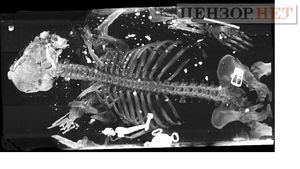
The whole mystery could have been solved in half a day by the autopsies of the pilots. No autopsy reports have surfaced – to my great amazement, but now I see this
- Unidentified Fragments Found in Bodies of MH17 Crew: Dutch Safety Board – RIA Novosti, Sept 10, 2014
- “Some fragments are found in the bodies of flight crew, pilots. We have to investigate them to see if they are fragments of the plane. If they are not, it might be fragments of the objects, coming from outside. We’re not sure yet what these pieces are fragments of. Experts are working with bodies,” DSB spokeswoman Sara Vernooij said.
The pilots are Malaysian, so one would expect the autopsies to be performed there. They should have known the truth all along, but evidently not. The Dutch have been holding on to the bodies and delaying the investigation for two months. If the object had been BUK shrapnel I believe we would have seen photos long ago. If they are not bullets then they are possible shrapnel from HE fragmentation bullets. -- Petri Krohn (talk) 17:50, 10 September 2014 (UTC)
- Was puzzled about the same. PS. It appears that Malaysia is inclined towards a missile theory. Malaysian Defense Minister had an unscheduled meeting with the Russian Defense Minister on 10 September, "to establish cooperation and ask for an advise". --Resup (talk) 18:27, 10 September 2014 (UTC)
- It is an aviation safety inquiry. All autopsies and body identification is part of it by agreement, so the Dutch are doing all that. For future air safety they have already established there was no pilot error or mechanical failure. They blame it on decompression caused by large numbers of small objects entering.
- What these objects were is a matter for parallel criminal inquiries. Unlike some American States, most countries do not publicise every detail of their criminal investigations as they go along. In this highly political case, that has attracted government level conspiracy theories, they'd do well to keep it extra quiet until finished.
- Although the locals who picked them up knew which bodies were the pilots, they do not seem to have been given any priority -- they were not formally identified until September 1. The condition of the bodies, by the time any experts saw them, may not allow calculating angles of shrapnel entry etc. But they can of course still remove all the foreign objects, Then they need all sorts of analysis to work out what they were.
- The best we can hope for is cannon bullets vs missile shrapnel. Exact type may not be possible. If it is, there is still the question of whose with high probability it is something used by everyone in the region. A2A cannon would exclude separatists, is all. A2A missile is capable of implicating entities so far not even suspected. They are going to be VERY CAUTIOUS ABOUT WHAT THEY RELEASE.KatKan (talk) 04:51, 11 September 2014 (UTC)
BBC reports on "25 pieces of metal", "the iron fragments." According to reports, Buk shrapnel will be from steel. Unfortunately, as far as I can tell, projectiles in other theories may be from steel, too (have not seen info, one way or another). --Resup (talk) 17:39, 12 September 2014 (UTC)
- Hm. From the pics we've studied here, apparently the type in question (not sure) it looks to me like rusty old iron. Not that I'm an expert. --Caustic Logic (talk) 12:00, 18 September 2014 (UTC)
Also via Associated Press: -- Petri Krohn (talk) 21:29, 12 September 2014 (UTC)
- Shooting down of MH17 'most likely' scenario: Chief Dutch prosecutor – Associated Press, Sep 12, 2014
- Detectives and forensic experts also are looking at 25 metal objects recovered from bodies and wreckage to see if they can offer any clues.
- "More investigation is underway to find out where these things came from," Zorko said.
- AP: 'A highly placed rebel officer told the AP in an interview after the disaster that the plane was shot down by a mixed team of rebels and Russian military personnel. ' Not true; Alexander Khodakovskii interviews are further discussed in the debunked topics. (PS. Other strong criticism of AP coverage was raised by Donbas side). --Resup (talk) 22:39, 12 September 2014 (UTC)
- http://toinformistoinfluence.com/2014/09/13/russian-air-force-commander-general-deynekin-buk-downed-mh17/
- http://ria.ru/mh17/20140910/1023539819.html
- https://ru.wikipedia.org/wiki/%D0%94%D0%B5%D0%B9%D0%BD%D0%B5%D0%BA%D0%B8%D0%BD,_%D0%9F%D1%91%D1%82%D1%80_%D0%A1%D1%82%D0%B5%D0%BF%D0%B0%D0%BD%D0%BE%D0%B2%D0%B8%D1%87
-- Petri Krohn (talk) 03:28, 18 September 2014 (UTC)
- RIA Novosti Deynekin expressed an opinion that foreign fragments found in pilot bodies can be coming from Buk. He called for searching for warhead shrapnel, or missile fragments, or even better missile number. He argued that the plane disintegrated in the air based on radar evidence, supporting powerful explosion like from Buk. He argued against air-to air version as SU bomber is slow and low altitude, and high altitude interceptors like SU 27 or MIG 29 were not present in the area.
- What he says is reasonable (indeed likely it was Buk), but he does not seem to have knowledge of facts not made public, and he does not really make any sensational statements either. --Resup (talk) 04:02, 18 September 2014 (UTC)
December 2014
- Boeing 777 disaster: missile elements found in victims' bodies – Joinfo, December 20, 2014 -- Petri Krohn (talk) 10:56, 20 December 2014 (UTC)
- "In the bodies of the passengers there are elements that are not the components of the aircraft. There are reasonable grounds to say that they are elements of the missile," Vovk said.
- Another MH17 Cover-Up: Hiding a Key Autopsy – Eric Zuesse, 2014/12/23
- This decisive evidence is the coroner’s report on the corpse of the airliner’s pilot. If the pilot was killed by bullets, then the standard ‘explanation’ of the downing (that the plane was downed by a ground-fired missile) isn’t just false, it’s an outright hoax. So: where’s the pilot’s autopsy?
Eric Zuesse makes the same observation we have made months ago. The article does not really contain anything new. Zuesse seems to be totally unaware of our work. He again sites Lufthansa pilot, Peter Haisenko as the highest authority, although he only ever looked at one medium resolution photo and made some wrong conclusions. -- Petri Krohn (talk) 13:18, 23 December 2014 (UTC)
August 2015
- The MH17 Pilot’s Corpse: More on the Cover-Up - Eric Zuesse, Aug 4, 2015
Zuesse still believes MH17 was shot down with 30 mm bullets. I disagree. -- 12:37, 5 August 2015 (UTC)
September 2015
- MH17 — DUTCH PREPARE MISSILE ATTACK ON MOSCOW - John Helmer, September 13, 2015
- At the same time, and apparently unknown in The Netherlands, an Australian coroners’ report on the identification and forensic testing of the bodies carried out in The Netherlands reveals post-mortem evidence to show that in their public statements the Dutch government officials have been lying about metal evidence they claim to have found. This evidence has not only been buried with the passengers’ remains. It has been buried by the Dutch Government and by coroners in the UK and Australia, who are now legally required to investigate independently what caused the deaths of citizens in their jurisdiction. All are withholding the CT scans, X-rays, autopsy and other post-mortem results, including metallurgical assays, the documentation of which accompanied the coffins of the aircraft’s victims from The Netherlands to their homelands.
- For the Dutch to make the case that MH17 was shot down by a Russian-made and Russian-deployed Buk ground-to-air missile, the metal in the corpses and body parts is the only certain evidence which has been recovered from the crash site; analysed painstakingly in the record of the Dutch investigations; and repatriated in certified dossiers Dutch and other sources say accompanied the coffins when they were flown home. This documentation is now held in files in The Netherlands and in the coronial agencies of all the countries to which remains and coffins have gone.
- 'Buk-deeltjes in lichamen slachtoffers MH17' - NOS.nl, October 6, 2015
- "The fragments were found in the bodies of the victims and the remains of the aircraft, are elements that resemble the examples from the BUK that was investigated. Those samples were given to experts for comparative research."
- DUTCH REPORTS ON MH17 HAVE MISTAKEN BUK MISSILE MODEL, WARHEAD TYPE — THE FOOTNOTE WHICH PUTS THE BOOT TO BUK - John Helmer, October 16, 2015
- From the evening of the crash day, July 17, 2014, western government officials and media reporters have blamed Russia for manufacturing the missile, ordering it fired, and causing the crash. They are now citing the Dutch reports as proof of the initial assignment of blame. This is despite the DSB’s reluctance to do so in its report; and despite the refusal to date of Australian and Dutch police, coronial investigators and pathologists to release the detailed autopsy evidence they have gathered of the shrapnel which struck the aircraft and the bodies of those on board. According to the DSB report, shrapnel killed the crew in the cockpit, and three pieces of shrapnel, characteristic of warhead type 9N314M , were found in the bodies of the pilot and co-pilot. No crew member or passenger in the aircraft, outside the cockpit, was struck by this shrapnel, according to the DSB.
- On these three pieces of metal hangs the case for a Buk missile detonation as the cause of crash; the cause of death; and Russian culpability for the shoot-down. But a search through the DSB records, and through the technical reports of shrapnel impact and blast simulation on which the DSB has based its conclusions, together with interviews with spokesmen for the Dutch investigations, finds that the only evidence for the source of the three metal fragments turns out to be a classified military secret of the Dutch Ministry of Defence.
- Guardian makes “error” reading MH17 report, accuses rebels of cover up – UPDATED - OffGuardian, October 14, 2015
Jeroen Akkermans' fragments
- MH17 crash: My revealing fragments from east Ukraine - Jeroen Akkermans, BBC, 16 April 2015
